Table of content
Product sampling campaigns are a hands-on way to drive brand awareness and deliver more qualified leads to your sales team. Besides helping potential customers develop a personal connection with your brand, letting people try before they buy is a surefire way to break through any hang-ups they may have about a product.
And now, after the era of COVID-19, when shops and malls were closed and experiencing new products in a physical way was more difficult or even impossible, this definitely changed the game a bit. People like to shop from home and test products before they go for the full version of the product. This definitely sheds new light on the importance of using physical samples in your digital campaigns.
In this article, we trace the sampling campaign’s journey from doorstep to digital. Later, we take a look at how, when, and if you should use this strategy for your business.

I have spoken about this at two different business events and in both cases, the topic caught lots of attention and our decision-making process plus the 4-step execution framework (which I have included in this article) got very positive feedback from the ecommerce business owners.
I hope it will prove to be the same useful to you too!
PS. If you’re a Polish-speaking person, below you can watch the abovementioned session from the 9th edition of the I Love Commerce conference.
Product Samples: A Marketing Classic
Using free samples to engage potential customers in a product is nothing new. Soapmaker Jonathan Tabbit put this exact tactic into practice in an effort to grow his business back in 1851.
The savvy manufacturer asked his workers to cut bars of soap into thin slabs which were then distributed around local neighborhoods for families to try free of charge.

Offering Product Samples is a marketing technique that worked way back in 1851 and can bring impressive results today if executed correctly
In a world where nothing could be obtained without payment, Tabbit’s idea was initially viewed with some confusion. However, his bold innovation paid off.
People used it. They tried it, they liked it, and then they simply wanted more. Tabbit went on to establish one of the most successful soap businesses of the time.
Other businesses imitated Tabbit, and today American multinational Procter & Gamble is one of the world leaders in offering physical samples of products in supermarkets.
Product Sampling in the Digital Era
With the invention of the internet and the blossoming of a new digital era, companies trading in the world of ecommerce were able to create digital sampling campaigns, such as running a special offer for an internet user to try out a subscription service for 14 days free of charge.
The structure and format of online product sampling campaigns generally mirrored that of their physical counterparts until Amazon’s Jeff Bezos took a revolutionary marketing step in 2019.
At the beginning of 2019, Jeff Bezos and Amazon introduced targeted digital sampling campaigns as a new opportunity launched by Amazon for advertisers.
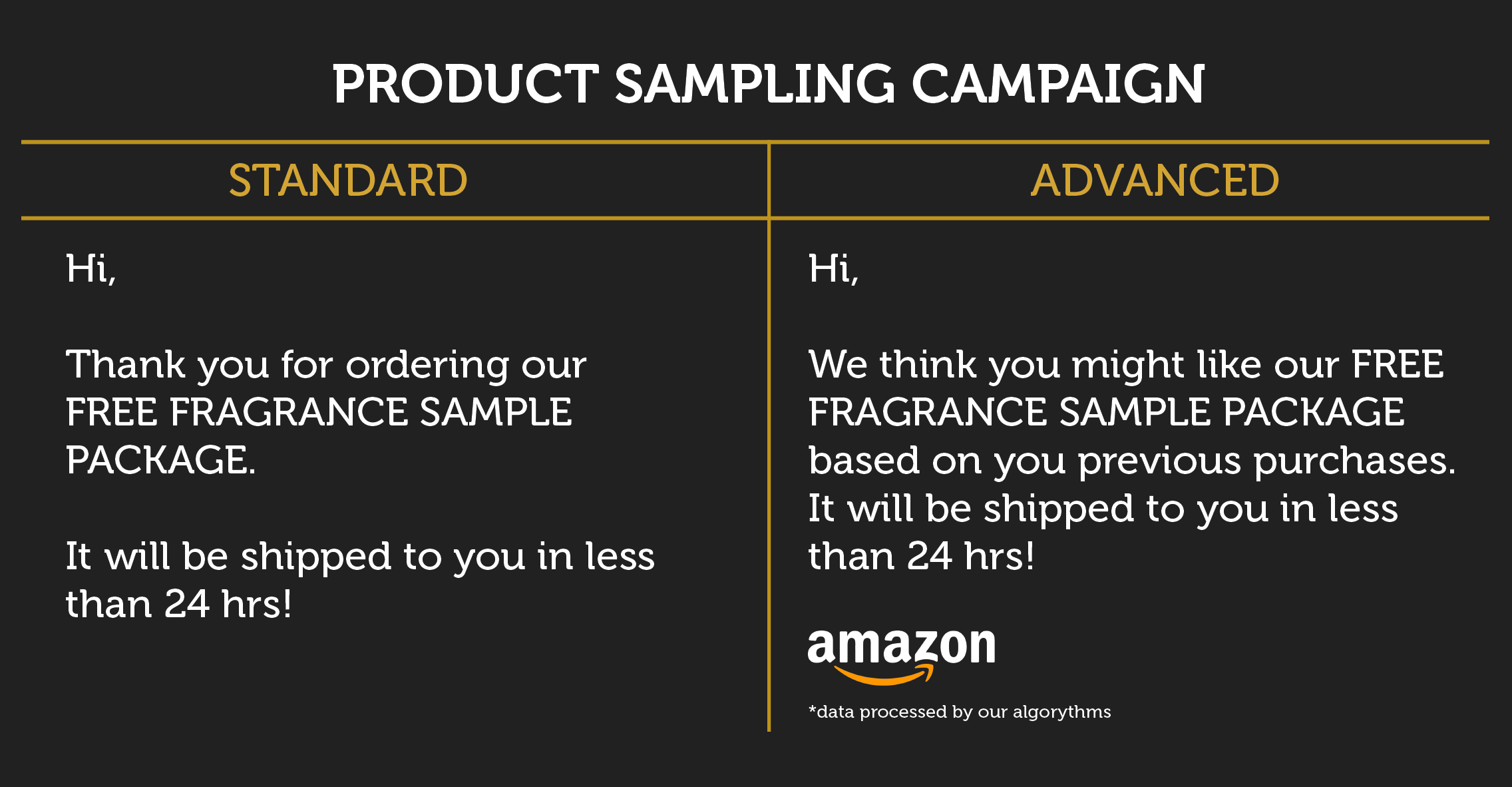
Going beyond traditional digital display or video advertising methods, Amazon launched a new targeted product sampling campaign in which samples of new products were sent out to customers. Algorithms and machine learning (ML) were used to select customers whose data marked them out as most likely to purchase that particular product.
This ad model is something that Amazon hopes will give it the edge over its biggest competitors for advertising revenue – Google and Facebook.
Amazon sampling campaign needs some adjustment though…. The initial feedback from Amazon Prime customers was that the campaign “freaked them out” – samples were too well matched to their needs and it opened their eyes to the fact how much Amazon really knows about them and their buying behaviors. But this is the subject of a whole other story…
Amazon’s move and massive investment into digital sampling mean that we as marketers or business owners should seriously look into sampling campaigns which are a really under-used marketing opportunity in the digital world.
3 BIG REASONS Why Digital Product Sampling Campaigns Are Under-Exploited
Although sampling campaigns can often be organized fairly easily through an existing ecommerce platform, not many organizations choose to introduce this type of marketing campaign. Here is why:
1. High UPFRONT INVESTMENT
A sampling campaign requires a higher investment upfront. From our experience, the conversion rate from the sampler to the actual final product buyer is somewhere between 10 and 15%. So, you really need to produce 10 times more samples than the amount of the final product.
2. Higher total COST OF CUSTOMER ACQUISITION
Advertisers, marketers, and business owners can also be put off from using a sampling campaign firstly because it is more complicated, and secondly, because should it fail, they will lose the cost of producing the samples on top of the money they have spent on the creation and dissemination of the advertising campaign through the media.
3. Higher EXECUTION COSTS
In addition to costing more to run than a typical marketing campaign, a successful sampling campaign demands more from a marketing team.
The execution costs of trial campaigns tend to be slightly higher because this type of campaign is a little bit more complex. You have more logistics and you need marketers who can do more than a simple performance campaign. They have to think about remarketing a lot more and about how email campaigns are tied into media campaigns, so you need slightly more skilled marketers to execute this campaign properly.
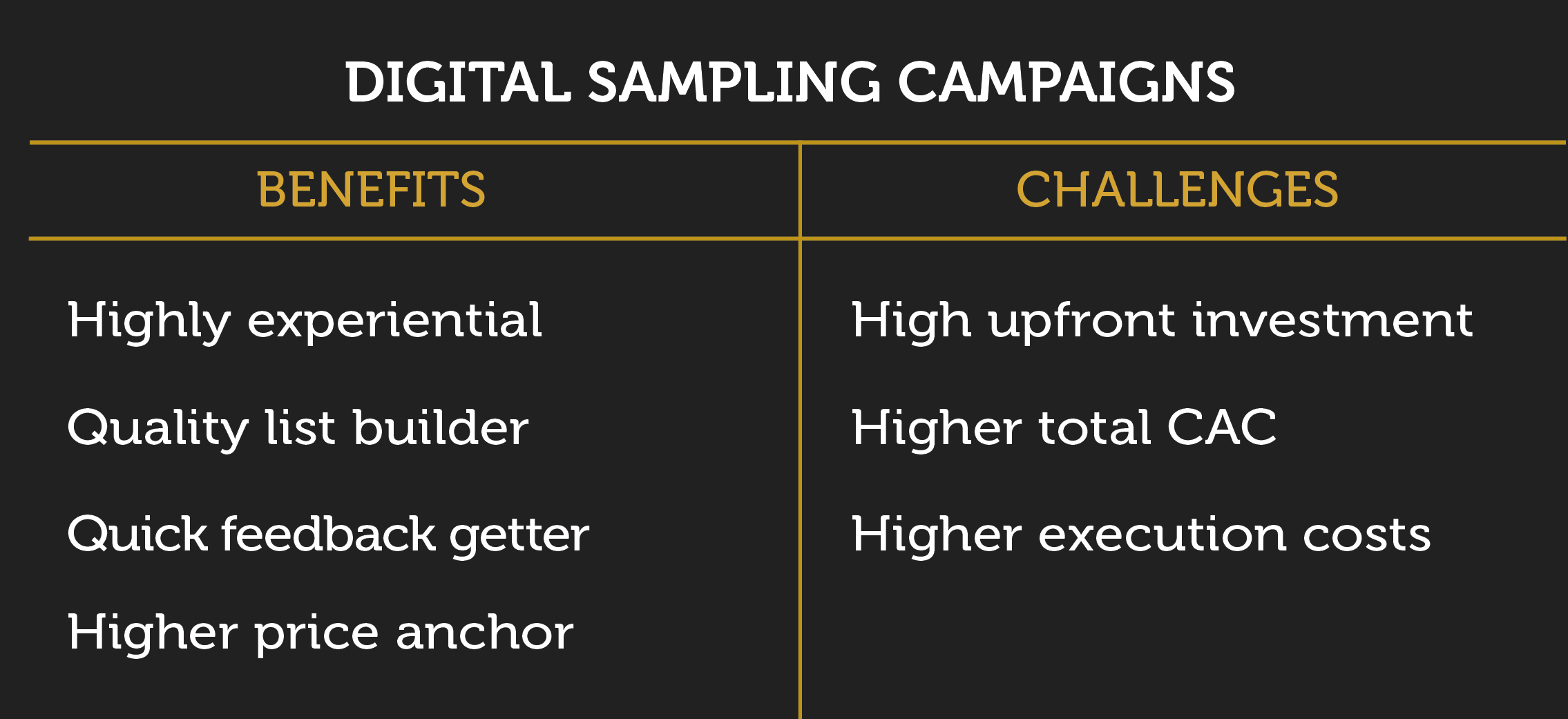
The Benefits of Ecommerce Product Sampling Campaigns
1. The most experiential digital campaign
The most obvious advantage of a product sampling campaign is that it allows potential customers to personally experience what is good about your product before they buy it.
For example, a dog food manufacturer who sends free trials of their product out to dog owners allows them to discover first-hand what it’s like to unpack, smell, and handle the product. This campaign would be especially useful for owners whose pets are very particular about what they eat as they can get immediate feedback on whether or not their pet likes it.
2. A quality list builder
Another advantage of a product sampling campaign is what it can do for a company’s email list.
The email base that you acquire through the sampling campaign is usually a much more valuable email base than you would acquire if you were just asking people to sign up for a discount at your e-store or to sign up for some special members club.
You’re actually getting an email base of people who physically touched and experienced your brand, your product.
3. Quick feedback getter
For a totally new product or brand, offering free trials or inexpensive samples is a great way to quickly obtain feedback, user testimonials, and reviews that will help to establish credibility. Even negative feedback collected in this way can be useful.
When launching its No Sugar product in Australia in 2017, Coca-Cola used an interactive product sampling campaign to gather multiple testimonials, videos, and pictures that could be used during the product’s first few months of life.
Coca-Cola Sampling Campaign to launch NO SUGAR version of the product; by giving out product samples and inviting celebrities like Kelly Rowland, the brand received a lot of direct feedback and testimonials.
We employed a similar tactic at tribe47 when working with a client to launch pet food brand product samples (though, unlike Coca-Cola, we didn’t have the amazing Kelly Rowland to boost our campaign; we had cute puppies instead!).
But even without Kelly’s celebrity endorsement, we were able to collect a lot of positive and also some negative reviews or feedback within the first few weeks that really helped us shape the message of the following campaign. That helped us exclude some possible objections and also helped us to simply collect a lot of user feedback that we could use later instead of the campaign.
4. Higher price ANCHOR
A further benefit can be gained from running a product sampling campaign prior to a product’s launch instead of bombarding the public with a confusing array of discounts.
When you are trying to establish a price point in people’s heads – especially when it comes to a new product or brand in the market – if you start with multiple aggressive promotions to get the best batch of clients, their brains might get seriously confused on which price point is the anchor. But, if you start with a trial campaign, it gives you a much clearer space to establish the higher price point of the product in their head.
It is much related to Daniel Kahneman’s theory of cognitive biases – anchoring.
How to Stand Out by Offering Sample Products Online
Although the idea of offering product samples has been around for a while, this style of marketing campaign is not encountered very often in the world of ecommerce. This scarcity can bring distinct advantages.
A very positive thing about the free trial campaign is that it’s still quite rare online, so you have a much higher chance to distribute your products in a viral way than you would have with any other type of campaign.
The Product Sampling Campaign That Doubled Sales
Displayed below are the results of two highly successful product sampling campaigns which led to a marked increase in sales. The first campaign was run by tribe47 when the client was entering the market in Poland. The second campaign was run by tribe47 on behalf of an American manufacturer of a sensitive feminine health product.
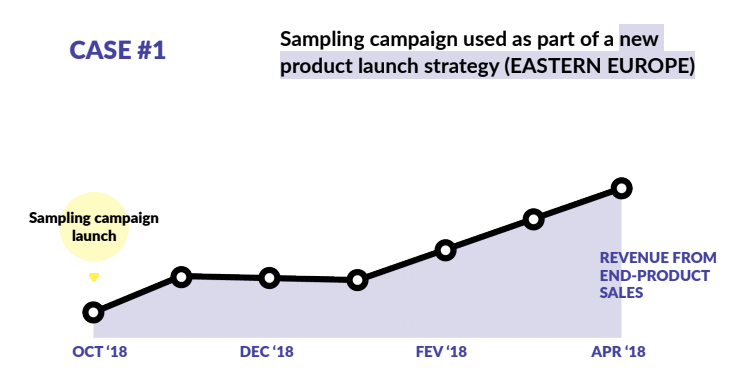
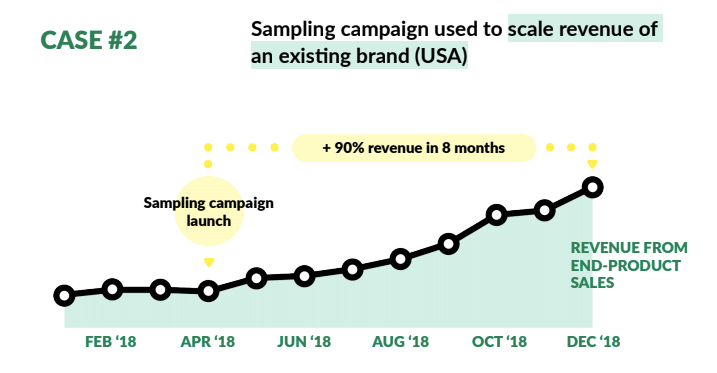
The second campaign had impressive results. We introduced the sampling campaign online around April. Without this campaign, we wouldn’t have been able to double the company’s revenue within eight months. It helped us establish new acquisition channels and also scale acquisition on the channels that were already established.
How to Launch Your Own Online Product Sampling Campaign in 4 Steps
Step 1 – Business Fit Check
Step one is an absolutely vital one. Before you start planning your own product sampling campaign for your ecommerce business, ask yourself if this type of marketing tactic is appropriate for your company.
If the risks are too high, then it might not be right for you. As a general guide, your product should adhere to the six following rules:
- Novelty
Is your product new? This type of campaign works best for products that are new or which have some new features. Unless there is some kind of innovation attached to the product, there will be little interest in trying it out. Don’t go for a sampling campaign if you have a product that is already very common in the market.
- Repurchase
Are you selling a product that inspires a systematic and frequent repurchase? Product sample campaigns work well for products that are bought regularly over a prolonged period of time, for example, cosmetics, feminine hygiene products, pet food, or food products for humans.
- Customer Lifetime Value
A high customer lifetime value means that you will recoup the costs of creating and distributing your free sample and remarketing your product to people who have tried it out. For a product sampling campaign to be cost-effective, your product needs to have a customer lifetime value of at least $75 per customer.
- Effect
It is only worth offering a small sample-sized trial of your product if it has an immediate and gratifying effect. If your product is an anti-aging face cream that takes months to work, then customers will not gain an understanding of its benefits after a single use. On the other hand, if your product is an instantly delicious chocolate cake, then members of the public can tell straight away that they like it and will want to buy it so that they can experience the same pleasure again.
- Overcoming Objections
Your trial product campaign will have the highest chance of encouraging product sales if it can overcome any misgivings members of the public may have about sampling your product. If you are selling a new skin cream, they might worry that it could cause an allergic reaction, or if you are selling new dog food, they might worry that their dog won’t eat it. Being able to try out products like these before making a financial commitment will greatly increase the chances of generating an actual sale.
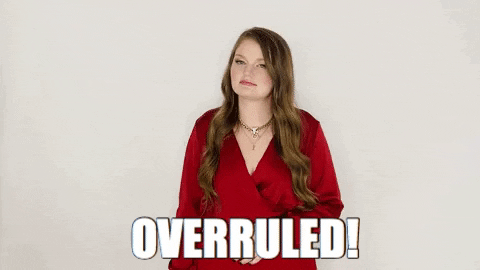
- Superiority
The final point to consider when deciding whether or not to run a product sampling campaign offline or online is whether your product is noticeably superior to those of your competitors. Your product needs to be so good that when someone tries it, they won’t want to go back to what they were previously using before.
Step 2 – Create a “Safe” Product Sampling Offering
If your product meets the six guidelines laid out above, then the next stage is to assemble a sample offering. It’s suggested to have a more measured approach to distributing samples than simply giving them out for free.
Our biggest advice here is that you should not be trying to give a sample totally for free. The sample should be free, but people should pay for something. Of course, the easiest thing, in this case, would be for them to pay for shipping and handling.

Ensuring people have to pay something to access a sample of the product is an easy way to sort the potential customers who are genuinely considering purchasing the full-size version of your product from the people who just like getting something for free.
People who just love a free promotion will really mess up your conversion rate from the sample to the end product purchase. They might be very willing to jump on the campaign quickly, but they will not purchase the main product.
Restricting the number of free samples per person is also very important if you want to run a successful and cost-effective campaign.
We actually disabled the option on our eCommerce site to purchase multiple samples. Take care of this one little element, because regardless of whether it’s Eastern Europe, Western Europe, or the USA, people will try to benefit from this offering a little bit more than you would want them to.
Step 3 – Plan the WHOLE Campaign (Not Just Sampling!)
As you come to plan your product sampling campaign, remember that it should be part of your overall marketing strategy to grow or launch your business. This means that it should be integrated and correlated to the other elements within your existing strategy, for example with the awareness stage of your company.
Instead of marketing a trial campaign to an audience that has never heard of your brand or product, precede it with a campaign that is educational, inspirational, or funny. This will help you build the brand, establish the product, and nurture a desire for it.
It’s not a very good idea to target a cold user base on any of the advertising platforms with that sampling campaign. Firstly, you want to avoid the promotion-seekers, and secondly, you want to increase the actual conversions and the chance that this campaign will turn out to be profitable.
In the case of the product sampling campaign mentioned earlier, which tribe47 ran on behalf of an American client, educational articles were published ahead of the sampling campaign launch to show potential customers what problems the product could solve.
The result was that the audience for the product samples had already had their interest piqued by high-quality educational content. Intrigued by what they had read, the “warmed up” audience was more inclined to purchase a sample. Sending user traffic first to the content and second to the trial landing page resulted in a lower cost per final acquisition.
- From Sample to Product Purchase
Be prepared to wait a while for your product sampling campaign to convert to actual product sales.
From our experience, there’s really a pretty long period of conversion from the trial taker to the end customer. This period takes on average 60 days and throughout the 60 days, you’re going to have multiple chances to convert a person who takes up your sample offer to the end product purchase.
An effective way to encourage people who sampled your product to take the next step of actually buying the full-size full-price sample is to upsell to them – give them a reason to upgrade or add a full product to the package.
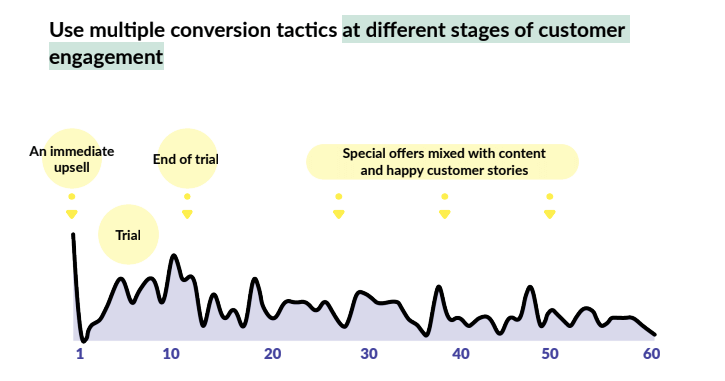
This will become a key optimization point in the whole campaign and your chance to pay off the sampling cost and sample advertising cost in full. Or, if you do a really good optimization, to even make your first small margin!
It’s also really important to establish a good relationship with your potential future customers when they are in the process of sampling your product.
In the first few days, when they are trying the product, make sure to establish a nice relationship through education about the brand and the product and give people a chance to buy the main product from the point at which they first see the goodness in it. Then, of course, make the moment when they have finished using your trial a special occasion.
- How Long Should a Product Trial Last?
People who sample your product are more likely to buy it if they have used it a couple of times and really noticed the benefits. Of course, this isn’t possible for every product, but if you are selling shampoo, for example, give them multiple small samples that they can use over a couple of days – give them a little bit of time to really immerse themselves in the product.
Package your product into five, three, or seven samples and give people some directions to use it frequently over a short period of time so they can really start seeing the benefit and start getting used to this new product.
At the end of a multi-day trial, when a potential customer has had the chance to become attached to a product, it’s time to drive the purchasing message home.
At the moment when they should be finishing the trial, give them a special deal. After that period, follow up with both content and special offer opportunities. Give them more reasons to buy.
- Geographic Considerations
If you’re marketing your product to a European audience, you will need to make sure your sampling campaign is compliant with the General Data Protection Regulation. That means that when users are purchasing the sample, you need to collect their consent to receive remarketing and emails designed to upsell your main product.
Step 4 – Count The Money
The final and very hands-on step is to create and execute your media campaign. It’s vitally important that your campaign is optimized from the perspective of the customer acquisition cost.
Don’t hang on to the sampling distribution costs. It is an important key performance indicator (KPI) and it should be measured, but if it’s not paired up with the end customer acquisition cost it’s going to be very hard for you to make your campaign profitable.
The journey from sampling to conversion could take up to two months and will involve some bad traffic i.e. people who will not convert to purchasing the main product.
You need to give yourself at least three to four months to run this campaign. Then you’ll have a chance to optimize, so, you have a chance to scale the distribution of samples based on the traction that you’re seeing.
What is also important, scale your campaign budget so that it doesn’t disappear too fast. Use the first month to optimize the campaign so that in the third and fourth months, you can really start getting a very good conversion rate from the sampling to the end product.
Last but not least, include the cost of the sample in the customer acquisition cost. Sometimes it won’t matter because your sample will be very cheap to produce. But if you have 10 samples that cost you $3, that is increasing your customer acquisition cost by another $30. So, you better be dealing with a really high customer lifetime value.



